Ruben Amorim brings a fresh tactical identity to Manchester United, combining his modern football philosophy with the demands of one of the world’s biggest clubs. Known for his structured yet attacking style, Amorim focuses on dynamic build-up play, compact defending, and effective transitions. His system not only enhances individual player performances but also ensures a cohesive, well-organized unit on the pitch. This analysis explores the key principles behind Amorim’s tactics at Manchester United, shedding light on his approach to formations, pressing strategies, and attacking patterns that are shaping the team’s new era.
Build-up
Under Rúben Amorim, Manchester United’s base formation in the build-up phase is a 1-3-4-3, providing a solid foundation for both control and progression.

Building up in a 1-3-4-3 formation focuses on creating numerical superiority in the midfield while maintaining width through the wing-backs. The three center-backs provide a solid defensive base, with the central center-back often dropping deeper to support build-up play. The two wide center-backs spread out to stretch the opposition’s press, creating space for the wingbacks to push up and occupy the flanks. In midfield, the double pivot provides passing options and ensures control in the center, while the front three stay high and centrally, ready to exploit any gaps in the opposition’s defense. This setup allows for fluid ball progression, quick transitions, and the ability to shift play across the pitch, making it difficult for the opposition to predict and intercept passes.
Low Build-up
Setup
In the low build-up, Amorim’s United usually rotate into a 1-4-2-3-1 formation, with the central center-back moving up as a holding midfielder and a holding midfielder pushing up into a number-ten position. The wing-backs will become fullbacks, and the three attackers will be very fluid, roaming in the central spaces.

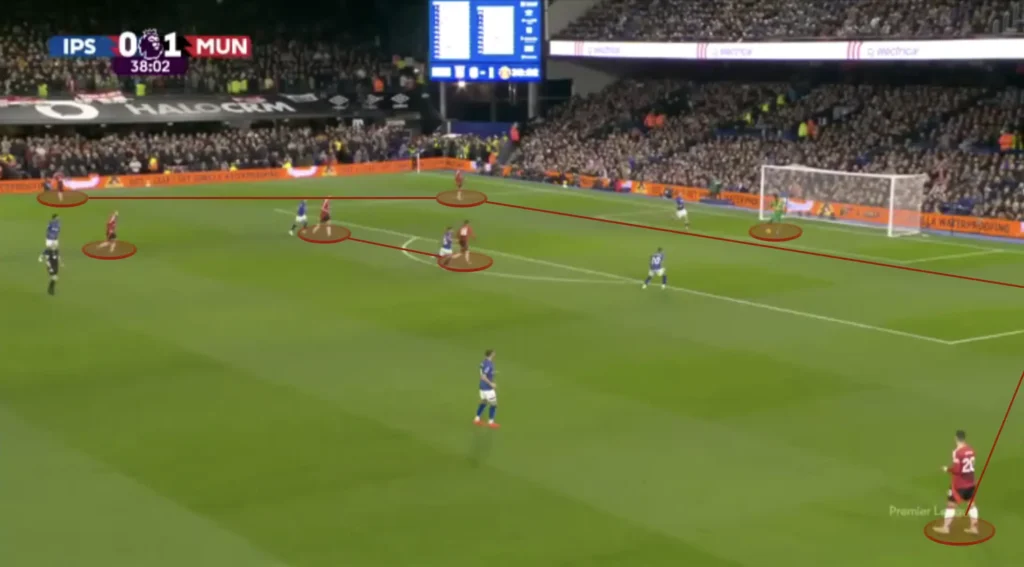
The Man United goalkeeper, André Onana, is very good on the ball and, therefore, Amorim wants him to push up between the center-backs in the low build-up. This allows the center-backs to come wider, while the fullbacks can push up on the wing.

This positioning usually gives United numerical superiority in the first phase of the build-up. It also helps stretch the opposition press, opening passing lanes to progress the ball through the midfield or directly to the advanced fullbacks.
Beating the Press
In the low build-up, Amorim mainly wants to beat the press by finding an attacking midfielder in the space between the opposition’s defense and midfield, who can bounce the ball to a holding midfielder, who then can progress the ball forward.


When United beat the press, the attackers will immediately make runs in behind, looking to quickly exploit the holes in the opposition’s backline.

The Man United players are also not afraid to be more direct in the low build-up. If the opposition comes up and presses man-to-man, there will be numerical equality up top with United’s attackers against the opposition defenders. Onana will often find an early longer ball up to the attackers, aiming to win 1v1 situations. The Man United attackers, mainly Rasmus Højlund, have good individual quality and will often win these battles to get the ball down and establish possession higher up the pitch.

High Build-up
In the high build-up, Amorim wants the wingbacks to push up as wingers, creating a 1-3-2-5 structure.

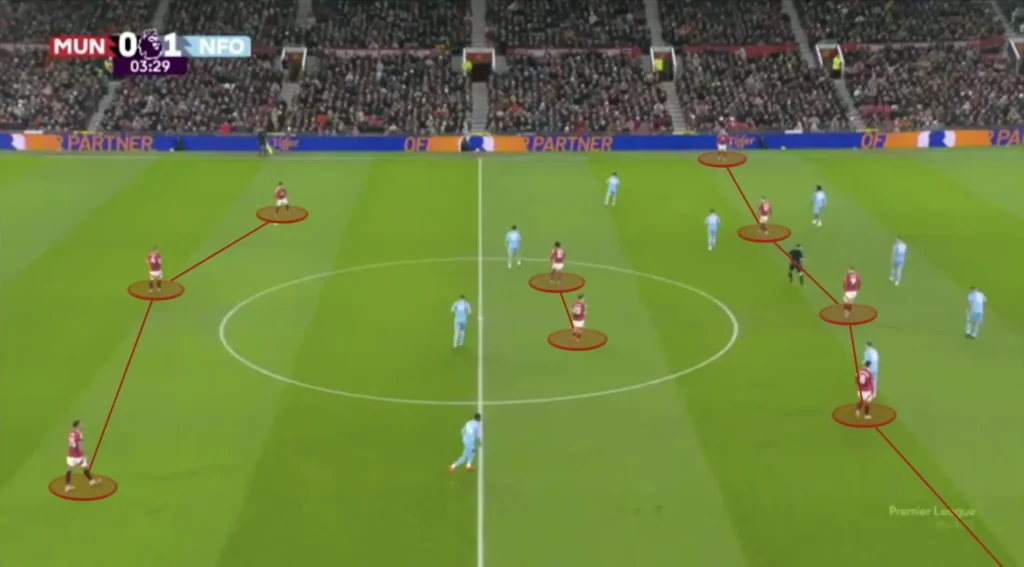
This allows Manchester United to overload the opposition’s defensive line, with five players positioned high to stretch the backline horizontally. Meanwhile, the central midfielders provide stability and quick recycling of possession, ensuring the team can maintain control while probing for openings.
Amorim wants the team, mainly the midfielders and the striker, to be very compact in the high build-up. This enables them to progress the ball through quick central passing sequences, making it difficult for the opposition to stay organized in their defensive shape.

Additionally, Amorim usually wants the two holding midfielders to be in different vertical lines during the build-up. This is crucial for creating passing lanes and disrupting the opposition’s defensive structure.

When the holding midfielders are staggered—one slightly ahead of the other—it forces the opposition’s attackers to make difficult decisions on who to block off, opening up space for the team to advance the ball. This layered positioning also enhances ball circulation by providing multiple angles for passing, reducing the risk of predictable or intercepted passes. The holding midfielders can play between themselves, allowing them to find third-man combinations to beat the opposition’s first line of pressure.
Numerical Advantages in the Middle
Man United will always have many players in the center. Ruben Amorim usually has a wingback/winger wide on each side and positions the remaining eight players in the middle.
Having only the two wingers out wide and the rest in the middle creates more options in the center and less space between the players. Amorim likes this because he prioritizes playing through the middle. He needs one player out wide to pull the opposition apart while the rest create numerical advantages in the midfield areas.
When a team outnumbers the opposition in the midfield, it can more easily retain the ball, exploit spaces, and progress the ball through the center. Man United will often progress the ball through quick central passes between the midfielders, beating the opposition’s press and exploiting gaps in the defense.
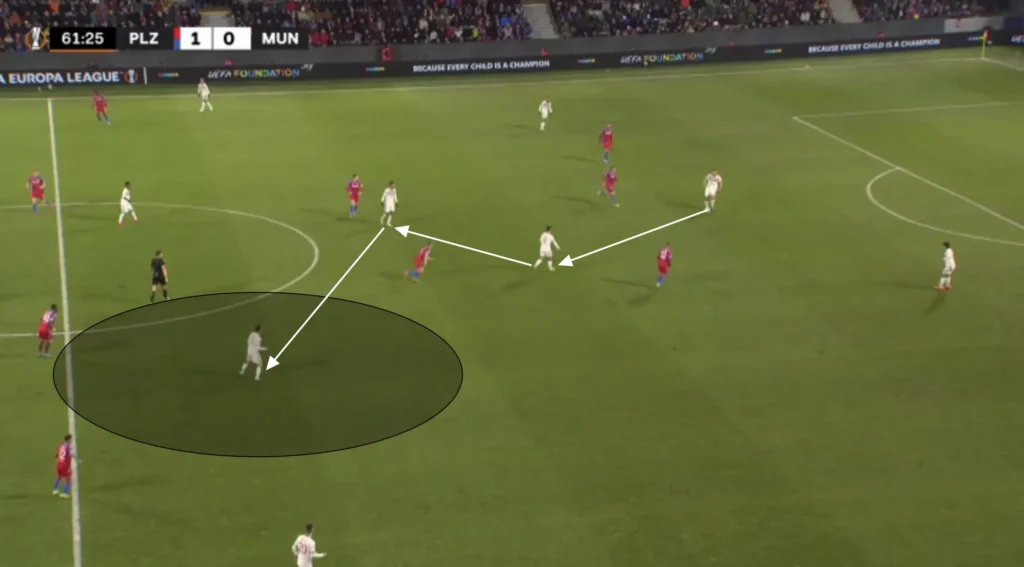
Another purpose for keeping many players in the middle is to shorten the distance between them. This shortens the length of the passes, which naturally shortens the time between passes. This means the opposition players will have less time to push up and press, giving the Man United players more time and control.
Rest-Defence
Amorim also wants many players close to the center to create a good rest-defence structure. Rest-defence in football refers to a team’s defensive organization and structure when they have possession of the ball, specifically aimed at being prepared to defend immediately if they lose it. A good rest-defence structure is crucial for maintaining balance and preventing counterattacks when the team is in possession.
Having many players in the middle and close to the ball gives Man United a good rest-defence, since it allows more players to counterpress when they lose the ball. When losing possession, the four or five United players closest will immediately jump on the opposition player with the ball and close the distance to cut off any passing lanes. This approach disrupts the opponent’s transition from defense to attack, forcing errors and creating opportunities to regain control of the ball.

Counterpressing like this keeps Man United on the front foot, allowing them to dominate possession and create more scoring opportunities. However, it requires exceptional fitness, tactical discipline, and teamwork.
Making Runs to Open Space for Teammates
Man United’s attacking play features constant player movement, with individuals consistently making runs to create space for their teammates. The team’s off-the-ball movement is key to their offensive strategy as these runs pull defenders out of position, creating gaps that allow for quick passes and through-balls.
The Man United midfielders will, for example, often make runs to open up space for a dropping striker. When a United defender has the ball, a midfielder might make a run out towards the side. This drags away an opposition midfielder, opening the space in the midfield for the United striker to drop into. The striker can get a pass from the defender and turn with the ball to progress it forward.


Third-Man
Ruben Amorim wants his team to play through the opposition when possible. One vital tool they often use to do this is the third-man principle. The third-man principle is a tactical concept used to create and exploit space by involving a third player in a passing sequence.
It typically works by having Player A pass the ball to Player B, who then quickly relays it to the free Player C. An opponent will block the pass from Player A to Player C, but the pass from Player B to Player C will be open, which is why he is needed in this passing combination.

This movement often bypasses an opponent’s pressing line and opens up space, allowing the team to advance the ball more effectively. The key to the third-man principle is timing and positioning, as the third player must anticipate the play, position themselves advantageously, and receive the ball in a manner that breaks the opposition’s defensive structure. This principle is integral to many modern football strategies, promoting fluidity, quick decision-making, and dynamic attacking play.
Man United will, for example, use third-man combinations involving the attacking midfielders to find an open holding midfielder in between the lines.


When they find their midfielders in these spaces, the attackers will immediately make runs in behind the opposition backline, looking to quickly get into goalscoring positions.
In this situation, for example, the players execute a third-man combination to find a holding midfielder between the lines, who then carries the ball forward. The attackers then start running in behind the opposition backline, allowing the holding midfielder to play a dangerous through-ball to the attackers.


Numerical Advantages Against the Opposition’s Defense
Another massive aspect of Man United’s high build-up is their ability to create numerical advantages against the opposition’s defensive line. Playing with a front five means the forward line naturally becomes numerically superior against a back four, which Amorims’s players are great at taking advantage of.

Amorim’s players mainly exploit this overload by creating 2v1 situations against the opposition fullback. These 2v1 situations will usually be found when United use quick switches of play. When the ball is on one side, the weak-side fullback becomes vulnerable to the switch of play due to the 1v2 against United’s winger and attacking midfielder.

The attacking midfielder can, for example, make a run in behind, which the defending opposition fullback usually will follow. This opens the space out wide for the United winger to be found with a long ball.


Amorim’s team often uses this to get the ball to the winger out wide, who can attack the opposition fullback and create 2v1 situations against him with the United midfielder.
Attacking the Half-Space
Amorim’s players usually look to create chances by attacking the space between the opposition center-back and fullback. They primarily do this from the wide areas with underlaps from the attacking midfielders. When the winger receives the ball out wide he will attract the opposition fullback. This opens the space between the fullback and the center-back, which allows Man United’s attacking midfielder to make the underlapping run into this space. The ball can be played to the underlapping player, who can cross the ball into the box or attack his defender in a 1v1 situation.

Additionally, the winger does not have to play the ball to the underlapping player. The run from the United midfielder will often drag away an opposition defensive midfielder, which opens the space inside. The winger can take the ball inside and shoot or find a pass to a free player in front of the backline.
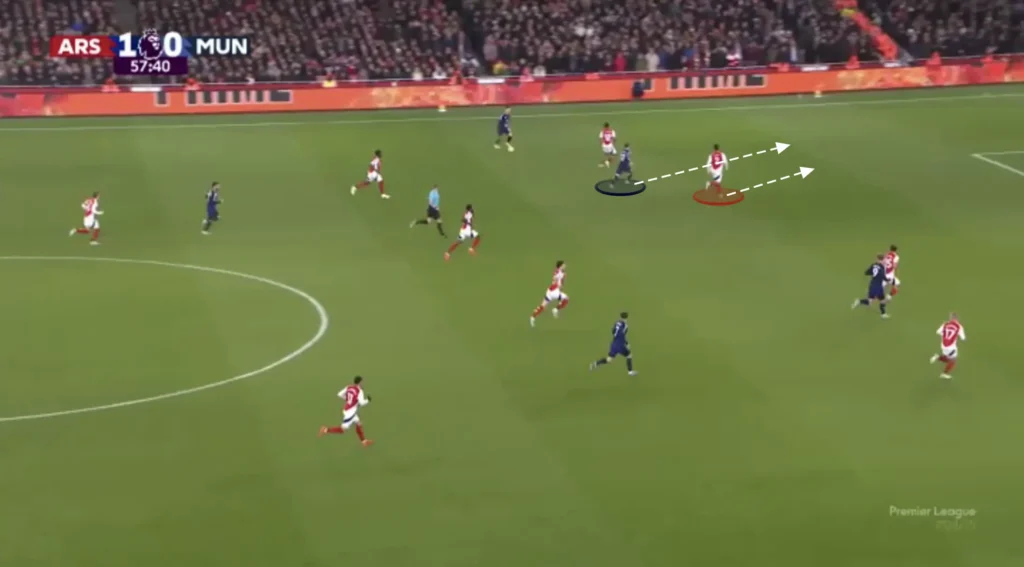

Defending
Manchester United’s base formation when defending is the 1-5-2-3 formation. They look to set up in a mid-block, always trying to close the center and force the opposition out wide.


Defending in a 1-5-2-3 formation is centered around maintaining a compact forward line that forces the opposition to progress the ball on the flanks. The back five ensures strong coverage across the defensive line, making it difficult for the opposition to exploit wide areas or break through the middle. The two central midfielders provide a shield in front of the defense, cutting passing lanes and supporting transitions. Meanwhile, the front three stay higher up the pitch, pressing the ball carrier and marking passing options to force mistakes or long balls.
Amorim centers his defensive strategy on regaining possession by steering the opposition to one side of the pitch. The striker initiates this by positioning himself to block central passing lanes, subtly nudging the ball carrier toward one flank. As this happens, the winger on that side follows closely, increasing pressure and cutting off easy outlets. This coordinated movement forces the opposition into a confined area where Man United can overload with additional midfield or wingback support.

Additionally, to stop the opposition from switching sides, the far-side winger will come up higher, being ready to jump on the opposition’s far-side center-back if the ball gets played to him. This usually scares the opposition away from switching sides, forcing them back to the same side, where United will increase the pressure and eventually win the ball.

High Backline
Ruben Amorim values compactness when defending and, therefore, wants United to defend with a high backline, making the space from the backline to the midfield line as small as possible. Defending with a high backline involves positioning the defensive line closer to the midfield rather than near the goalkeeper. This tactic compresses the space available for the opposing team to operate, disrupting their build-up play and increasing the chances of winning the ball back quickly.

A high backline also allows defenders to support the midfield more effectively, creating numerical superiority in central areas and facilitating quicker transitions from defense to attack. However, it requires defenders with good pace and positional awareness to deal with long balls and prevent opposing attackers from exploiting the space behind.
Additionally, everyone must be in the same line when defending with a high backline to maintain an effective offside trap, ensure cohesive coverage, and reduce gaps that attackers can exploit. A well-aligned defensive line makes it easier to catch opposing forwards offside, preventing them from receiving the ball in dangerous positions.
Body Position
When defending with a high backline, the defenders must always be ready to run back if the ball gets played in behind. Amorim, therefore, puts a lot of focus on the defender’s body position. He wants them to play side-on, being ready to run both forward and backward. Tracking a run in behind is more difficult when facing forward than if you play side-on. If you are facing forward, you have to turn your entire body before starting to run. Playing side-on gives a quicker reaction time, enabling faster movement in both directions.

Aggressive Center-Backs
Another notable aspect of Man United’s defensive style is their aggressive center-backs. The center-backs are never afraid to push up on an opposition midfielder to stop them from turning and driving with the ball.

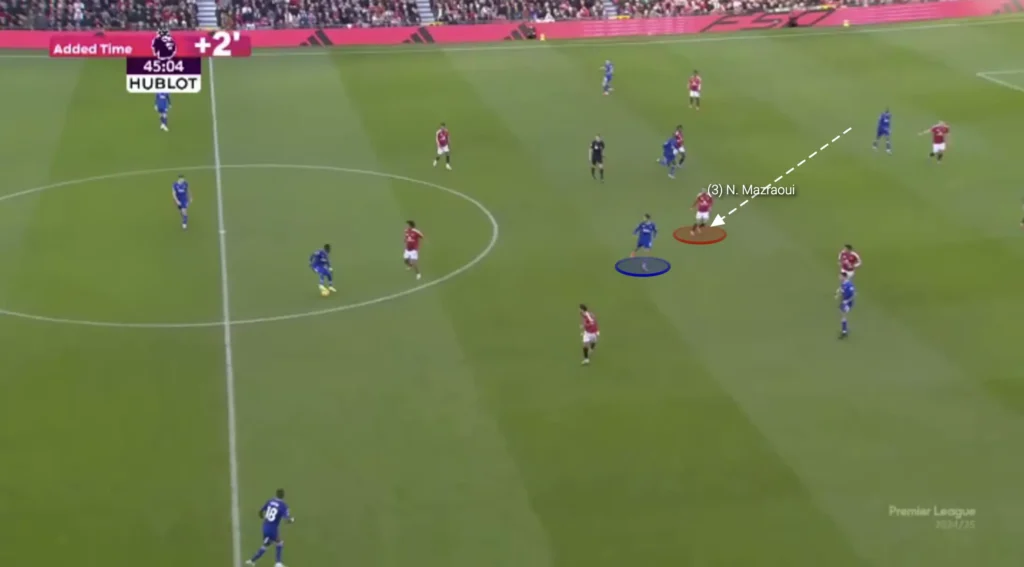
This forces the opposition back while giving the United midfielders and attackers more freedom to push up and press when defending. The problem with pushing up a center-back is that big spaces get created between the defenders. Amorim’s players are, however, great at solving this. The backline will quickly become a compact back four, with the defenders coming across to close the space that the pushing center-back opened.
Counterattacks
Ruben Amorim usually wants his team to counterattack in their offensive transitions. When they win back possession, the United players immediately shift into attack mode, looking to exploit any space left by opponents. The central midfielders play a crucial role in initiating quick, vertical passes to the forwards or wide players, who are already positioned to make penetrating runs. This rapid transition is often supported by overlapping wingbacks, providing width and stretching the opposition’s defense. With these quick movements, the United players frequently catch teams off guard, creating high-quality chances before the opponent can regroup defensively.

Additionally, the Man United players are great at finding open spaces in the counterattacks. Instead of playing the ball straight forward where opposition defenders may still be positioned, they play a sideways or diagonal pass, allowing the team to bypass pressure and shift the play into open areas. From these areas, the United attackers can take the ball forward and quickly get past the opposition to create a goalscoring opportunity.

Man United also try to involve many players in their counterattacks to create numerical advantages, making it difficult for opponents to predict the next move.

This is one of the reasons why they defend with the wingers high up and centrally. When the wingers are central, they are closer to the opposition’s goal, which enables them to immediately contribute to the counterattack when United wins the ball.
Final Thoughts
Rúben Amorim’s appointment as Manchester United manager marks an exciting new era for the club. His tactical philosophy, centered around quick attacking play, disciplined structures, and adaptability, offers a fresh approach to United’s style. Amorim’s emphasis on dynamic transitions and highly compact defending could unlock the full potential of United’s squad while instilling a clear identity on the pitch.
The players’ ability to quickly adapt to his methods will reveal itself soon, but Amorim’s track record of success and innovation gives Manchester United fans plenty of reasons for optimism. This is a bold step toward modernizing United’s tactics, and it might just be the foundation for a return to the top of English and European football.
